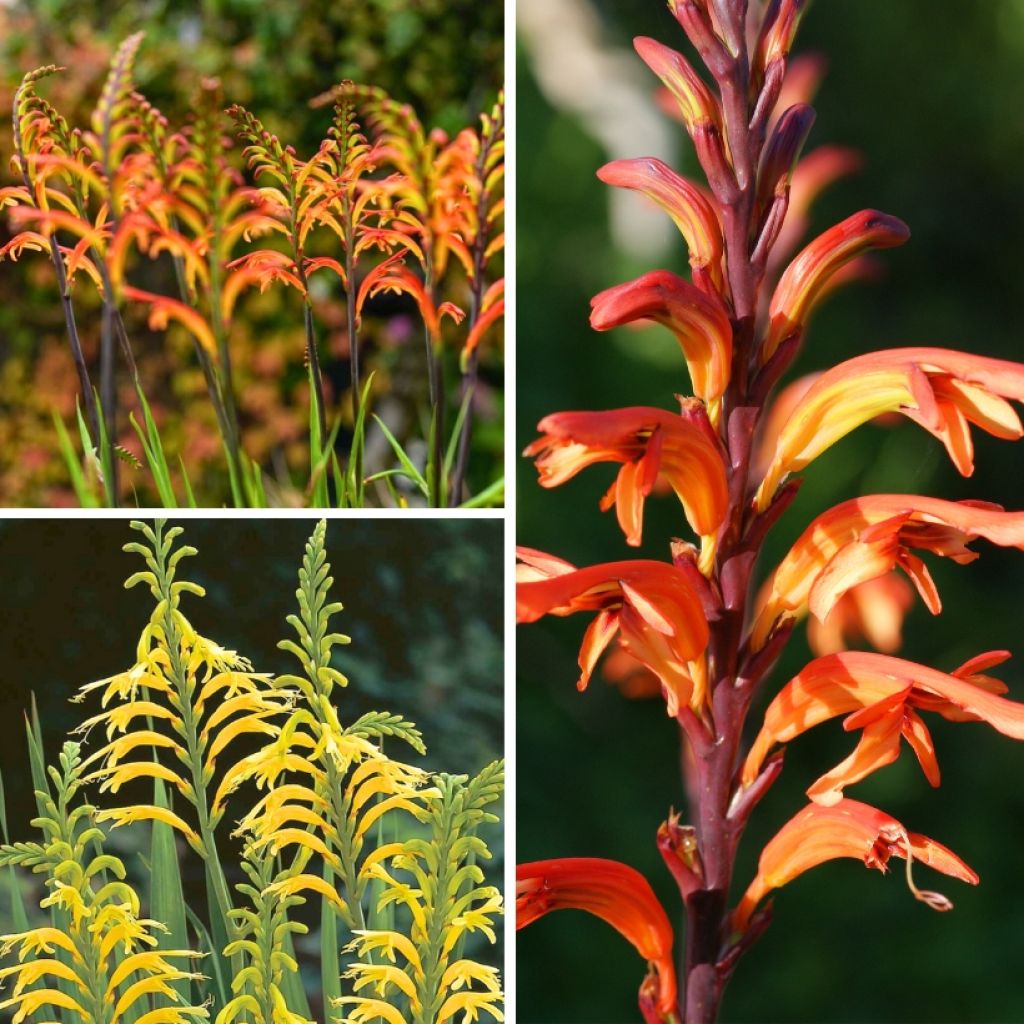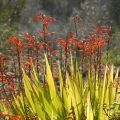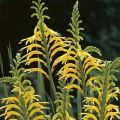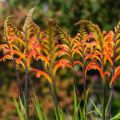Shipping country and language
Your country of residence may be:
Your country of residence is:
For a better user experience on our website, you can select:
Your shipping country:
Andorra
Austria
Belgium
Bulgaria
Canada
Chile
Croatia
Cyprus
Czechia
Denmark
Estonia
Finland
France
Germany
Greece
Hungary
Iceland
Ireland
Italy
Latvia
Lithuania
Luxembourg
Malta
Monaco
Netherlands
Poland
Portugal
Romania
Slovakia
Slovenia
Spain
Sweden
Switzerland
United Kingdom
We only deliver seed and bulb products to your country. If you add other products to your basket, they cannot be shipped.
Language:
French
German
Spanish
English
My Account
Hello
My wish lists
Plantfit
Log in / Register
Existing customer?
New customer?
Create an account to track your orders, access our customer service and, if you wish, make the most of our upcoming offers.


Chasmanthe Collection - African Flag
Chasmanthe Collection - African Flag
Chasmanthe floribunda sp., Duckittii, Saturnus
Cobra Lily
Order in the next for dispatch today!
Dispatch by letter from €3.90.
Delivery charge from €5.90 Oversize package delivery charge from €6.90.
More information
This item is not available in your country.
Schedule delivery date,
and select date in basket
This plant carries a 6 months recovery warranty
More information
We guarantee the quality of our plants for a full growing cycle, and will replace at our expense any plant that fails to recover under normal climatic and planting conditions.
From €5.90 for pickup delivery and €6.90 for home delivery
Express home delivery from €8.90.
Does this plant fit my garden?
Set up your Plantfit profile →
Collection items (9 plants)
Description
This magnificent Collection of Chasmanthes brings together three exceptional varieties: the Chasmanthe floribunda, and its 'Duckittii' and 'Saturnus' varieties. Each one is distinguished by its summer flowering in warm tones, ranging from flaming red to sunny yellow. Originally from South Africa, these tall perennials with corms are adapted to mild winters. They develop an iris-like, vibrant green, deciduous foliage, and their flower spikes rise up to 1 m (3ft) in height. Plant them in large pots as well to bring an exotic touch to the terrace or balcony.
The collection consists of:
3 x Chasmanthe floribunda: This plant is distinguished by its deep red flowers.
3 x Chasmanthe floribunda 'Duckittii': unique with its golden yellow flowers, this variety brings exceptional brightness to the garden, and its habit is more compact than the other two.
3 x Chasmanthe floribunda 'Saturnus': its flowers in shades of orange harmoniously blend with its dense foliage for a beautiful structure.
Individually labelled.
The Chasmanthe floribunda is a plant of South African origin that closely resembles a Crocosmia in its overall appearance. Just like the latter, it develops into a beautiful dense and upright clump from which sturdy flower stems adorned with brightly coloured flowers emerge. However, its flowers are finer and theoretically appear in spring. Much more adapted to Mediterranean-type climates than its parents, Crocosmia, Chasmanthe floribunda are easily cultivated in open ground on the Mediterranean coast.
Place Chasmanthe floribunda Duckittii at the forefront, while the taller Chasmanthe floribunda and its 'Saturnus' variety will form a majestic background. In borders, these plants should be spaced about 40 cm (16in) apart.
Easy to cultivate in containers or borders on the Mediterranean coast, vigorous but demanding, Chasmanthes are planted in partial shade or full sun, in groups of 10 corms, in light, fertile soil that remains moist throughout their growth period. Their warm-toned blooms form splendid combinations with annuals (nigellas and poppies) and fit well in exotic settings, with Agapanthuses taking over in summer. Their association with garden Irises and Grasses is always successful.
Plant habit
Flowering
Foliage
Botanical data
Chasmanthe
floribunda
sp., Duckittii, Saturnus
Iridaceae
Cobra Lily
Antholyza floribunda
South Africa
Planting and care
The Chasmanthe floribunda can be grown in the ground in Mediterranean regions spared from severe frost, mainly along the coast. It is planted in early autumn. The corm is destroyed at -5°C (23°F) and the foliage, which develops in autumn and winter, will be destroyed as soon as it freezes. Everywhere else, it will be planted in spring and most often grown in a large pot, which allows it to be protected from frost in winter. Alternatively, it can be grown like a gladiolus, meaning it is planted after the last frost and the corms are dug up in autumn, to be stored in a dry and cool place. It will then bloom in summer.
Plant the corms at a depth of 8-9 cm (3-4in). The growing substrate should be light, well-drained, rich, and remain slightly moist throughout the growth and flowering period until the foliage starts to turn yellow. On the other hand, the plant should be kept dry after flowering, during its dormant period. Opt for a good quality potting soil mixed with a little sand. Overwinter your potted plant in a bright, cool, but frost-free location.
Planting period
Intended location
Care
This item has not been reviewed yet - be the first to leave a review about it.
Haven't found what you were looking for?
Hardiness is the lowest winter temperature a plant can endure without suffering serious damage or even dying. However, hardiness is affected by location (a sheltered area, such as a patio), protection (winter cover) and soil type (hardiness is improved by well-drained soil).

Photo Sharing Terms & Conditions
In order to encourage gardeners to interact and share their experiences, Promesse de fleurs offers various media enabling content to be uploaded onto its Site - in particular via the ‘Photo sharing’ module.
The User agrees to refrain from:
- Posting any content that is illegal, prejudicial, insulting, racist, inciteful to hatred, revisionist, contrary to public decency, that infringes on privacy or on the privacy rights of third parties, in particular the publicity rights of persons and goods, intellectual property rights, or the right to privacy.
- Submitting content on behalf of a third party;
- Impersonate the identity of a third party and/or publish any personal information about a third party;
In general, the User undertakes to refrain from any unethical behaviour.
All Content (in particular text, comments, files, images, photos, videos, creative works, etc.), which may be subject to property or intellectual property rights, image or other private rights, shall remain the property of the User, subject to the limited rights granted by the terms of the licence granted by Promesse de fleurs as stated below. Users are at liberty to publish or not to publish such Content on the Site, notably via the ‘Photo Sharing’ facility, and accept that this Content shall be made public and freely accessible, notably on the Internet.
Users further acknowledge, undertake to have ,and guarantee that they hold all necessary rights and permissions to publish such material on the Site, in particular with regard to the legislation in force pertaining to any privacy, property, intellectual property, image, or contractual rights, or rights of any other nature. By publishing such Content on the Site, Users acknowledge accepting full liability as publishers of the Content within the meaning of the law, and grant Promesse de fleurs, free of charge, an inclusive, worldwide licence for the said Content for the entire duration of its publication, including all reproduction, representation, up/downloading, displaying, performing, transmission, and storage rights.
Users also grant permission for their name to be linked to the Content and accept that this link may not always be made available.
By engaging in posting material, Users consent to their Content becoming automatically accessible on the Internet, in particular on other sites and/or blogs and/or web pages of the Promesse de fleurs site, including in particular social pages and the Promesse de fleurs catalogue.
Users may secure the removal of entrusted content free of charge by issuing a simple request via our contact form.
The flowering period indicated on our website applies to countries and regions located in USDA zone 8 (France, the United Kingdom, Ireland, the Netherlands, etc.)
It will vary according to where you live:
- In zones 9 to 10 (Italy, Spain, Greece, etc.), flowering will occur about 2 to 4 weeks earlier.
- In zones 6 to 7 (Germany, Poland, Slovenia, and lower mountainous regions), flowering will be delayed by 2 to 3 weeks.
- In zone 5 (Central Europe, Scandinavia), blooming will be delayed by 3 to 5 weeks.
In temperate climates, pruning of spring-flowering shrubs (forsythia, spireas, etc.) should be done just after flowering.
Pruning of summer-flowering shrubs (Indian Lilac, Perovskia, etc.) can be done in winter or spring.
In cold regions as well as with frost-sensitive plants, avoid pruning too early when severe frosts may still occur.
The planting period indicated on our website applies to countries and regions located in USDA zone 8 (France, United Kingdom, Ireland, Netherlands).
It will vary according to where you live:
- In Mediterranean zones (Marseille, Madrid, Milan, etc.), autumn and winter are the best planting periods.
- In continental zones (Strasbourg, Munich, Vienna, etc.), delay planting by 2 to 3 weeks in spring and bring it forward by 2 to 4 weeks in autumn.
- In mountainous regions (the Alps, Pyrenees, Carpathians, etc.), it is best to plant in late spring (May-June) or late summer (August-September).
The harvesting period indicated on our website applies to countries and regions in USDA zone 8 (France, England, Ireland, the Netherlands).
In colder areas (Scandinavia, Poland, Austria...) fruit and vegetable harvests are likely to be delayed by 3-4 weeks.
In warmer areas (Italy, Spain, Greece, etc.), harvesting will probably take place earlier, depending on weather conditions.
The sowing periods indicated on our website apply to countries and regions within USDA Zone 8 (France, UK, Ireland, Netherlands).
In colder areas (Scandinavia, Poland, Austria...), delay any outdoor sowing by 3-4 weeks, or sow under glass.
In warmer climes (Italy, Spain, Greece, etc.), bring outdoor sowing forward by a few weeks.


